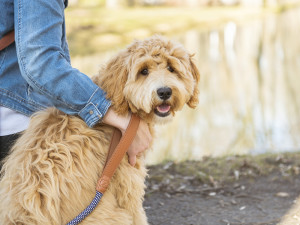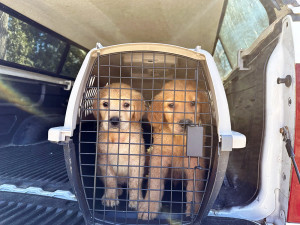How to Protect Your Pet During LA’s Canine Crime Wave
Dognappers are targeting designer breeds like French Bulldogs. We asked a pet detective for tips on how to keep your pup safe.

Share Article
“Dognapping” might sound like a catnap with more snoring involved, but it is far from something to sleep on. In a violent January case opens in a new tabreported on by Los Angeles Magazine, two men in Los Angeles attacked a man who was walking his dog, pointing a gun at him and punching him many times before taking off with his French Bulldog, Albert.
The dog was later rescued when the police linked one of the thieves to a homicide committed eight weeks earlier. “I got a gun license. I hate guns. But if you want to have a dog in LA you have to have a gun,” Ron York, the man whose Frenchie was stolen, told Los Angeles Magazine. “They shoot me, no problem. But no one will touch Albert again.”

Get (totally free) deals for food, treats, accessories, tech, and way more pet parenting must-haves.
opens in a new tabThere’s an ongoing dognapping problem in LA.
Kinship first reported on LA’s dognapping crime wave when Lady Gaga’s case made headlines; last February, a group of men robbed Lady Gaga’s dogs, shooting and hospitalizing her dog walker, Ryan Fischer, in the process. But the theft wasn’t linked to Gaga’s high profile — instead, it was indicative of a larger concern among the city’s pet parents. And in the time since Gaga’s dog was stolen (and returnedopens in a new tab, thankfully), the problem of dog theft has only grown.
It’s an especially pressing issue for the dog parents of Frenchies, a breed that’s been disproportionately targeted. As designer dogs, French Bulldogs have the potential to bring in a lot of money if resold by thieves. That makes them — and their pet parents — a target.
Some of the thefts have been extremely violent.
Recently, a woman went viral when her dog was stolen and she was captured on video clinging to the hood of the caropens in a new tab that the thieves had escaped into. She jumped in front of the vehicle instinctively, hoping to stop the criminals from leaving with her dog, but they simply sped off — with the victim still holding onto the windshield. “I thought I was going to die,” she told ABC 7 Chicago at the time. Her dog still hasn’t been returned.
This kind of crime is on the rise.
These stories highlight a growing problem in So-Cal that, unfortunately, doesn’t usually end with the dogs returning home.
“They’re either being sold or they’re being bred,” says JoAnn Powell, co-founder of Dog Days Search and Rescueopens in a new tab, a California nonprofit that helps owners find their lost pets. “They know if [a dog] has not been altered they can breed it, or if it’s been altered, they know they can sell it at a higher price.”
Depending on the breed, dogs are being sold for anywhere between $3,000 and $10,000 according to Powell. It’s why many designer dogsopens in a new tab, such as Goldendoodles, Malteses, and Yorkshire Terriers are popular targets. It’s also why, above all, French Bulldogs seem to be by far the most common victims. And while particular breeds are a newer aspect, dognapping has been an issue for some time.
“People have been stealing dogs for a long time. It’s only in recent years that there’s been particular breeds, like Frenchies or Bulldogs that have taken up a popularity with celebrities. So therefore they’re getting more publicity because of it. They’re the type of dog that’s getting stolen and now it’s making news but it has been happening for a while,” says Powell.
There are complicated origins of the town’s problem.
Another culprit of this increase in dognapping is the same reason for so many problems in this country — misguided and vaguely written legislation. “One of the reasons dog thefts were rampant,” Chris DeRose founder of Last Chance for Animalsopens in a new tab told LA Magazineopens in a new tab, “was that Class B dealers were actually licensed to steal pets by the U.S. Department of Agriculture for many years. They’d ‘legally’ steal your dog and sell it to breeders or researchers. Five years ago, we got the practice of Class B dealers — a Class B license is issued to dealers whose business includes the purchase and/or resale of warm-blooded animals — declared illegal.”
Making matters worse, only 10 states have specific laws making dog theft a misdemeanor, including California, Connecticut, Delaware, Michigan, New Hampshire, North Carolina, Rhode Island, Texas, Washington, and West Virginia. A few states have strengthened their animal laws. Virginia, Louisiana, Oklahoma, New York, and Mississippi have laws making dog theft a felony. But for many of those states, it varies depending on the dog’s perceived worth.
DeRose, a former actor known for his appearances on detective dramas like Cagney & Lacey, CHiPs, and The Rockford Files started Last Chance for Animals nearly four decades ago with the mission to halt animal exploitation and fittingly quickly became a leading pundit in dog-related crime. Beyond being quite possibly the most LA story ever, his experience is indicative of how long this has been an issue in the area and the speed at which it has developed.
However, not all dog thieves are driven by sinister intentions. In fact, in many cases, it’s quite the opposite, according to Karin TarQwyn, a private investigator who specializes in petsopens in a new tab. “The most commonly stolen dog is a French Bulldog. But in most cases, people aren’t stealing the dog. Mostly, when a person takes what they think is a stray Bulldog, they just think they’re being a good Samaritan or abiding by finders keepers,” she told Slate.opens in a new tab
The American Kennel Club has also previously pointed towardopens in a new tab the Great Recession as a cause for rising canine theft. The AKC suggests that when the economy dips, people may not be willing or able to pay for rescue fees or the going rate of a new dog, while others may look at it as a means of earning extra cash through selling.
How to help prevent dognapping
As TarQwyn describes it, this problem is likely not going away any time soon because there are simply very few repercussions for this form of theft. “The truth is that they’re not going to get in any trouble — the risk of taking a dog is not very high,” she explained to Slate. “Police are never interested in the case, since it’s your word against the other person’s.” While it is of course not the pet parent’s fault if their pet gets grabbed, there are a few strategies to minimize your risk and prevent future abductions, according to Powell.
1. Microchip your dog.
Possibly the most effective solution is to ensure your dog is microchippedopens in a new tab. If a dog is stolen and sold to someone ignorant of the pet’s true origins, when they bring them to the vet for initial screenings the situation will quickly be clear.
2. Buy a GPS dog collar.
Similarly, if you have the means, purchase a smart collar or one with GPS tracking available like a Whistle Switchopens in a new tab. This way, you’ll have a window to locate your dog until the collar is removed, which in many cases can be a significant amount of time and enough to get them back home safely.
3. Keep your pet on a leash.
When protecting your dog from thieves, it’s best not to make it easy for them. But that’s exactly what walking your dog without a leash is doing. Not to mention, it’s a bit inconsiderate and dangerous for other pups who may be reactiveopens in a new tab.
4. Don’t leave your dog unattended.
Powell recommends not leaving your dog in the front yard unless it is secure and private enough that they’d not be visible to bystanders. Additionally, don’t leave your dog unattended in a car — that’s too easy for dognappers.
5. Be careful who you buy from.
If you’re purchasing, rather than adopting, a pet, make sure they’re from a source you can trust. “People should be cautious when purchasing any of these breeds and make sure they know where the animal is coming from,” Powell says. “Don’t just buy them off some for-sale site without doing the research and making sure they’re reputable breeders.”
Beyond that, if you’re bringing a designer dog into your life, it’s important to recognize the additional caution that’ll be necessary. As Powell puts it, “If they buy an expensive breed that they know is more inclined to be stolen, they need to be careful about their home. They need to make sure they have security features in. They need to be careful about who they talk to about having their new pets in the home.”

Sean Zucker
Sean Zucker is a writer whose work has been featured in Points In Case, The Daily Drunk, Posty, and WellWell. He has an adopted Pit Bull named Banshee whose work has been featured on the kitchen floor and whose behavioral issues rival his own.
Related articles
![Golden retriever running around a local park during sunset]() opens in a new tab
opens in a new tabThe Macro Benefits of Microchipping Your Dog
Sure, microchips can feel a little 1984. But if your pup has a chip, they’re four times more likely to make it home if they get lost.
![designer dog breed Labradoodle on a leash looking at the camera]() opens in a new tab
opens in a new tabFrom Goldendoodles to Puggles — the Truth About “Designer Dogs”
Do your research. Know the facts.
![tripod dog / dog with three legs]() opens in a new tab
opens in a new tabWhy You Should Adopt a “Less Adoptable” Dog
Here’s why you shouldn’t rule out senior dogs, special-needs pups, bully breeds, or tripods.
![Man holding a dog in front of a light gray background]() opens in a new tab
opens in a new tabYou’ve Adopted a Dog From a Hoarding Case. Now What?
Hundreds of dogs have been rescued from hoarding situations so far this year. Here’s what their adopters should know, according to animal welfare experts.
![2 Golden Retriever puppies in a crate]() opens in a new tab
opens in a new tabNearly 30 Golden Retrievers Were Rescued From Inhumane Conditions in Rhode Island
The dogs — 20 of them puppies — will be available for adoption in the coming weeks.






